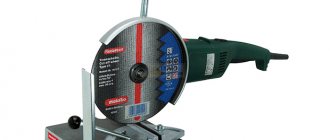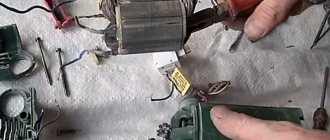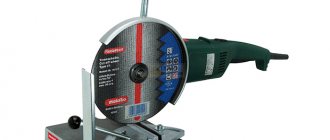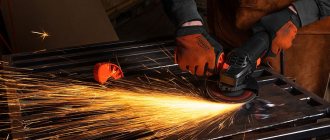How to make a grinding disc for an angle grinder with your own hands + video
For high-quality metal grinding, it will not be enough to buy an angle grinder; you will need to select a disc. Using different attachments for an angle grinder, you can cut, cut, clean and even grind metal and other materials.
Among the incredible variety of grinder circles, it is sometimes difficult to make a choice even for a specialist in his field.
This article will help you navigate the types of materials and operating principles, and at the end you will learn how to make your own scraping disc for a metal grinder.
Assortment of attachments
The most common products for processing automobile bodies are: sponge-like, abrasive with varying degrees of grain, felt, having a soft surface. They are conventionally classified according to the type of production into two types:
- petal (has high productivity and high price);
- surface grinding (made like a rubber disc with an additional coating for processing).
The material for these items is dense foam rubber or felt, which has different diameters. However, kits are sold that consist of several elements that have different purposes and manufacturing complexity.
Making your own nozzles
If there is no suitable option on sale, then for a disk with a high level of rigidity you can make a soft layer of great thickness and place it between Velcro and a plastic base. Using a utility knife, you need to cut off the Velcro where the soft layer will be glued. For the soft layer, a bath sponge is mainly used. It must be remembered that individual elements can shift, breaking the overall symmetry.
You can also use a felt disc, which is used in a polishing machine and machine. First, you should make a pin with a suitable diametrical size and apply a thread on one side. On this side you need to secure the disk, which is surrounded on both sides by a wide nut and a limit washer. This device is not difficult to manufacture and can be used to process various surfaces.
Application nuances
A drill attachment for car polishing can be purchased at any store that sells car products. However, you should choose these devices carefully.
Body elements of new cars are made using modern technologies. An anti-corrosion compound and paint are applied to the metal, which are wear-resistant. They will last approximately 15 years. However, this coating is better preserved if it is properly cared for. The polishing device restores the original shine and removes defects from the surface. Together with a special product, such a product will cost less than services provided in a workshop.
Form
Car polishing attachments are usually made in the form of a cone or a circle. They often come as an addition to polishes, along with polishing belts and sheets. There are many options that are used for both bodywork and jewelry or optics.
Thanks to such elements, the aesthetic and technical characteristics of the car are preserved, since any vehicle will look much better after a thorough washing and polishing.
Body polishing
The polishing process can correct only some defects. If there is corrosion, chips or damage on the body through which the steel frame is visible, then a major repair will be required.
Before starting the polishing process, you should carefully inspect the vehicle to ensure that any imperfections can be eliminated.
Treatment of the body with a special device will give a positive result if:
- slight difference in shades that resulted after partial coloring;
- the presence of roughness, scratches and cloudy stains;
- faded layer of paint;
- the appearance of graininess and streaks of enamel.
You need to know that you can’t overuse polishing, because when you do it, the paint layer becomes smaller by 5 micrometers. From the date of manufacture of the vehicle, no more than 20 polishing procedures can be performed. At this time, you need to use a thickness gauge, especially if the car is used.
Polishing agents
Before you begin restoring the surface, you should make sure you have the necessary materials, such as:
- sandpaper;
- bike;
- foam;
- polishing compounds;
- polish.
Treatment products should be carefully selected. Pastes with abrasive particles are necessary to remove the top varnish layer. They are selected according to the type of cracks and chips on the surface. Preparations with a large number of particles are indispensable when eliminating noticeable defects. Compositions that add brightness to color are quite common.
Cloudy stains often appear on the protective coating of new cars; in this case, you can use a restoration paste that does not contain grinding additives.
A variety of polishes allows you to choose the right product for any task. Thick pastes are suitable for vertical surfaces. They can be used to treat any part of the car. Such products are often characterized by the presence of components that increase the brightness of the shade.
Liquid polishes are only suitable for horizontal surfaces, for example, the hood or roof. The main advantage is the absence of the possibility of damage to the enamel.
Aerosols are quite convenient to use. Such compositions are economical and effective in operation. But it is worth noting that the cans, despite their size, do not contain much material.
Using a polishing wheel
By using a polishing wheel on a drill, you can update the appearance of your car. This procedure is most effective if you need to smooth out small chips or remove tarnishing of the surface.
The work is carried out in 2 stages:
- removing paint from the body surface;
- applying polishing compound.
Protective treatment is also carried out to reduce the negative effects of various types of precipitation and ultraviolet radiation. It is mainly done when preparing a car for sale. A protective layer (it contains wax or silicone) is distributed over the surface of the body to form a film that is invisible to the eye, repels moisture, and makes the body shiny. You can polish a used car with a soft pad if there is no paint damage. It can also be used with careful treatment with a protective agent.
How to make a toothbrush soft: recommendations
People who respect themselves and others are raised from childhood to constantly monitor and care for their teeth and mouth. They know that beautiful white teeth and pleasant breath affect health, personal life, and help build a successful career.
And in order for everything to always be in order in your mouth, you need to brush your teeth regularly - this has been known since childhood. The most popular item for oral care is an ordinary toothbrush.
Parents teach them to use it from a very early age. However, even they do not always know the criteria for choosing a much-needed tool.
They often do not know how to care for it and how often to change it.
Those who do not know the answers to these simple and important questions are very likely to risk damaging both their tooth enamel and gums. There is a high risk of getting a bunch of incurable diseases, and not only the mouth, but also other organs will be affected. To prevent this from happening, you should pay attention to some nuances when buying a toothbrush.
Brush selection methods
Typically, toothbrushes are purchased in modern perfume stores or pharmacies. When choosing, many people look at price and appearance and focus only on them, but these are by no means the main indicators. What should you pay attention to, how to choose correctly?
The first factor that you should take a close look at is the material used to make the bristles. There is an opinion that natural bristles are the best option. But this is far from true. Bacteria accumulate on it, leading to oral diseases. The best one is artificial: it has harder fibers, and the tips do not scratch the enamel, destroying it.
Information about the stiffness of the bristles is written on the packaging or the brush itself. According to the degree of hardness, brushes can be
- Very soft. Recommended for little ones or those with extremely sensitive teeth.
- Soft. Designed for older children 6–13 years old, recommended for adults with oral health problems
- Average. Good for teenagers.
- Tough. These brushes are used by adults with absolutely healthy teeth. Before use, it is recommended to consult a dentist, otherwise there is a risk of damage to the gums and enamel.
Using water
How to make a toothbrush soft? Often people purchase a brush with the required parameters, but after some time it becomes too hard, rubs the gums and causes discomfort. What can you do in this case, without running back to the store for a new copy? There are several tools that can make your toothbrush soft and brushing your teeth a pleasant and comfortable experience.
The easiest and most affordable way to soften a brush is with ordinary tap water. How to do it? Follow the instructions below:
- Under running hot water - there is absolutely no need for it to be boiling water. Otherwise, the plastic bristles will simply melt. You need to hold it with the bristles up for several (2-3) minutes.
- Then put hot water in a glass or jar and leave the brush there for 5–7 hours. The best thing is to do this in the evening after brushing your teeth before going to bed.
- In the morning, when you start brushing your teeth, you may find that the bristles have become soft.
Another way to soften your toothbrush is to use hydrogen peroxide. It is best to take a three percent solution. This is usually present in the first aid kit of anyone who takes care of their health.
Peroxide is poured into a glass or mug one third full, and a brush is placed in it for about 5–7 minutes. Then it is thoroughly washed. That's it, now you can use it.
Rinse aid
Surely a considerable number of people use mouthwash. It can also be a good option for softening your toothbrush.
This is done as follows:
Half a glass of rinse aid is poured - this amount is enough for the brush head to be completely immersed in it. After which a brush is placed in the solution. Depending on the stiffness of the bristles, the duration of the event ranges from two to three minutes to half an hour. The effectiveness of this technique has long been tested and proven - the villi will become soft and pleasant to the teeth.
Vinegar
Many people soften their paint brushes by soaking them in vinegar. If this method softens paint brushes, then it will work for toothbrushes. Another method to make your toothbrush soft is to soak it in a vinegar solution or pure vinegar. Any will do - table, apple or wine. But, as a rule, most people have a regular dining room in their kitchen.
How to do it?
- Vinegar is poured into a vessel (preferably transparent). You don't need a lot - just enough to completely hide the stubble.
- The dishes are placed in the microwave and heated - it is not necessary to boil, just make the liquid warm.
- Dip a brush into vinegar and leave for half an hour.
- After the appointed time, the brush is pulled out and rinsed under running water.
- To achieve a better effect, the bristles can be kneaded with your hands.
Aloe vera
Another way to make your toothbrush soft is to use aloe vera extract. It is usually used to moisturize and soften the skin. It will also quite successfully soften the bristles of the brush.
The procedure is carried out in three stages:
- The glass is filled one third with extract.
- Place the brush in the dish so that the head is completely hidden.
- After fifteen minutes, the brush is pulled out and rinsed.
That's it, she's ready to brush her teeth again.
Common salt
How to make a toothbrush soft at home? There is another very accessible and simple way. In order to try it, you will need simple table salt:
- A thick saline solution is made - the more salt, the better.
- A brush is dipped into the solution and left for several hours. You can leave it overnight.
- In the morning, the brush is washed and used for its intended purpose. After such a “bath” she will become soft and pleasant.











